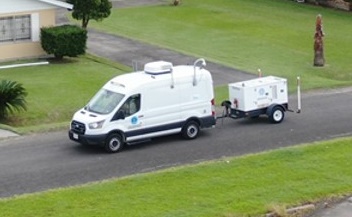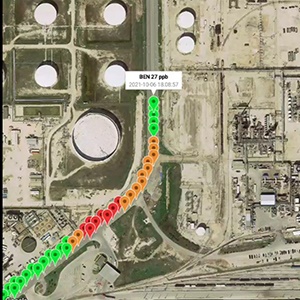Mobile Monitoring Comparison Values
The official table of MMCV values is Appendix A. Since this is a living document and the material is dynamic in nature, the document may be periodically updated. Any changes or updates to the values can be found in Appendix E.
MMCVs are screening values that allow TCEQ to analyze the instantaneous chemical concentration data generated by the mobile instruments, both in terms of whether concentrations are higher than usual (compared to baseline air concentrations), and from the perspective of the potential for acute health effects from exposure.
Two primary goals for evaluating chemical concentrations from mobile monitoring data are:
- To identify chemical releases and respond with the goal of stopping the release.
- Not necessarily tied to chemical toxicity.
- To determine if the chemical levels could cause adverse effects and respond by mitigating exposure.
- Exposure mitigation can include working to stop the release, leaving the area, and other methods.

TCEQ has several ambient air monitoring instruments in specialized vehicles that can collect instantaneous data while in motion (mobile monitoring) for activities such as field investigations and emergency events. These instruments can provide accurate, real-time, measurements (typically in 1-30 second intervals) of the concentrations of select chemicals in ambient air while the vehicle is in motion or stationary.
Evaluating these real-time instantaneous measurements to determine abnormal levels and/or the potential for health concerns required a new set of comparison values.
TCEQ’s Toxicology, Risk Assessment, and Research Division developed mobile monitoring comparison values (MMCVs) because:
- Historically, instantaneous concentrations have not been evaluated for the potential to cause adverse health effects.
- TCEQ field staff require reliable screening levels that they can apply to decisions about appropriate actions to take based on the measured chemical concentrations found while monitoring.
Based on these considerations, TCEQ developed four different types of fit-for-purpose air data screening levels. These levels can be used in near real-time to help monitoring staff and field investigators make more informed decisions about actions such as:
- Identifying and characterizing chemical sources.
- Initiating stationary monitoring or collecting canister samples to obtain longer duration measurements for toxicity evaluations.
- Mitigating exposure to staff when chemical concentrations are at higher levels.
All MMCVs are set at levels well below those that would cause health effects
The purpose of the instantaneous baseline-derived investigation level (iBDIL) is to identify the presence of an abnormally high concentration of any monitored chemical in the ambient air, so that a follow-up source investigation and actions to decrease emissions can be carried out if necessary.
Key points about iBDILs:
- Instrument- and chemical-specific.
- Set at 10-times higher than the chemical baseline, with the instrument- and chemical-specific baseline determined by evaluation of mobile monitoring surveys.
- Not based on levels at which the chemical could cause health effects, because a chemical with a low toxicity that is being measured at levels much higher than are typical indicates a release that may require action (even if the measured concentrations don’t indicate a concern for human health).
The purpose of an instantaneous health-protective investigation level (iHPIL) is to indicate that an evaluation of the potential for chemical toxicity is warranted. An exceedance of an iHPIL could prompt stationary monitoring for 30 minutes to 1 hour, or collection of a 30-minute canister sample, as determined to be appropriate by TCEQ field staff. The resulting average concentrations can be evaluated for the potential to cause toxicity using a comparison value of an appropriate longer duration (e.g., 1-hour air monitoring comparison value (AMCV) or EMHBAL1hr).
Key points about iHPILs:
- Health-protectively set equal to a 1-hour acute health-based comparison value such as a TCEQ 1-hour AMCV.
- Instantaneous chemical concentrations below the iHPIL will not cause health effects, but risks from concentrations above the iHPIL cannot be directly judged, therefore triggering further toxicity evaluation.
The purpose of the instantaneous health-based action levels (iHBALs) is to indicate when more rapid or greater action of TCEQ field staff may be required. An exceedance of an iHBAL could prompt stationary monitoring as well as increased vigilance for potential exceedance of an exposure mitigation value.
Key points about iHBALs:
- Set equal to 3-times a 1-hour acute health-based comparison value such as a TCEQ 1-hour AMCV.
- If an instantaneous concentration exceeds the iHBAL, then an exceedance of a longer-duration, health-based screening level such as the 1-hour acute health-based comparison value may also occur.
The purpose of the exposure mitigation health-based action levels (EMHBALs) is to indicate that an evaluation of staff safety may be needed (i.e., staff may choose to take steps to decrease their potential for exposure in the field); as well as an evaluation of the need to communicate information to regional managers and/or incident command (as deemed applicable by TCEQ field staff). EMHBALs were derived for three durations: 5-10-minute average (EMHBAL10min), 1-hour average (EMHBAL1hr), or instantaneous concentrations (EMHBAL1sec). The EMHBAL1sec is the primary exposure mitigation value that will be used by TCEQ field staff when data cannot be averaged in real-time in the field.
The EMHBALs are set at levels well below those that would cause health effects.
Key points about EMHBALs:
- The EMHBAL10min is set based on the lesser of: 3-times the 1-hr acute health-based comparison value, one-half an appropriate 15-minute occupational short-term exposure limit if available, or one-half an appropriate occupational ceiling value.
- Only used when field staff have the ability to average data in real-time while monitoring.
- The EMHBAL1hr is set at 2-times the 1-hr acute health-based comparison value.
- Only used when field staff have the ability to average data in real-time while monitoring.
- The EMHBAL1sec is set at 6-times the 1-hr acute health-based comparison value.
- Selected Ion Flow Tube Mass Spectrometer (SIFT-MS or SIFT)
- The SIFT-MS monitors ambient volatile organic compound (VOC) concentrations, with more than 1,000 compounds available in the SIFT-MS library, at parts per billion levels.
- In addition to using this technology for investigations and emergency events, it can assist in identifying unknown compounds associated with nuisance odors.
- Differential UV Absorption Spectroscopy (DUVAS)
- The DUVAS is used to identify potential emission sources of benzene, toluene, 1,3-butadiene, styrene, and sulfur dioxide at parts per billion levels. Nine other compounds can be qualitatively measured.
- Real-time maps are generated on a dedicated tablet, which displays compound concentrations and Global Positioning System (GPS) coordinates on an aerial satellite map.
- Picarro
- The Picarro monitors hydrogen sulfide at parts per billion levels. This instrument can be used to conduct area surveys or stationary continuous hydrogen sulfide measurements.
- Nephelometer
- The Nephelometer monitors concentrations of particulate matter smaller than 2.5 microns (PM2.5) in real-time.
TCEQ’s DUVAS van produces real-time visualizations of monitored data, termed caterpillar trails, using 4 colors that are associated with different chemical concentrations: Green, Orange, Red, Purple
Basis for color designation:
- Green: Below instant baseline-derived investigation level (iBDIL)
- Orange Threshold: above iBDIL
- Red Threshold: above instant health-protective investigation level (iHPIL)
- Purple Threshold: above instant health-based action level (iHBAL)
Note: For DUVAS caterpillar trails, concentrations above the EMHBAL1sec will also appear as a purple color.

The scientific justifications for the methods chosen for deriving MMCVs are provided in Derivation of Comparison Values for Evaluation of Ambient Air Chemical Concentrations Collected by Mobile Monitoring Instruments.
The official table of MMCV values is Appendix A. Any changes or updates to the values can be found in Appendix E.
Document appendices that describe how we derived specific MMCVs:
- Comprehensive list of all mobile monitoring comparison values developed by TCEQ (Appendix A)
- Derivation of chemical- and instrument-specific baselines (Appendix B)
- Example decision guides and chemical fact sheets for staff use while monitoring in the field (Appendix C)
- Selection of acute health-based comparison values (Appendix D)
- List of the available EMHBALs10min, STELs, and ceiling values (Appendix E)
- List of the available EMHBALs10min, EMHBALs1hr, and AEGLs (Appendix F)

 Back to top
Back to top